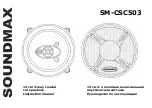
Serious Performance™
14
Knowledge
Fluance’s knowledge center is designed with you in mind. These tips and
articles have been written by Fluance industry experts to help you optimize
your home theater system.
Visit us online to learn more: www.fluance.com/Knowledge.html
Power Ratings
It is best to have an amplifier that exceeds the power of the speakers that are
connected to it. For example, a 30 watt RMS rated amplifier at high volume
will cause clipping and distortion when connected to a speaker with 100 watt
RMS. This will produce harmful electronic signals that will potentially damage
your speakers.
Do I have to bi-amp or bi-wire my connections with your speakers?
Some of our models have speaker wire connections to allow for bi-
amplification or bi-wiring. This is for your benefit and can be used to enhance
the performance of your system. Connection of a basic audio system where
there is only one connection from the amplifier is very simple and bi-amp or
bi-wire is not necessary. You can connect your speakers using the regular left
and right speaker wire connections and ignore the second set of terminals.
There are gold-plated bridges connecting the two sets of terminals that allow
the speaker to be connected as a traditional loudspeaker. Only remove these
bridges if you plan to bi-wire or bi-amp your speakers.
How do I use the bi-wiring connections to increase the performance of
my system?
A bi-wire compatible speaker has 4 binding post terminals. These two sets
of terminals allow the speaker to be split into two independent sections. The
split connects the mid and high frequency drivers to one set of terminals
and the low frequency driver to the other pair. In the bi-wire connection the
bridges connecting the two sets of terminals are removed and separate sets
of speaker wire are run from the amplifier to each section as shown below.
How do I use the bi-amplification connections to increase the performance
of my system?
Bi-amplification is the use of two amplifiers for both speakers. One amplifier
is connected to the woofer section of a loudspeaker while the other is
connected to the combined mid and tweeter section. Each amplifier
operates over a restricted frequency range. This restricted range presents
each amplifier with a much simpler job and each amplifier is less likely to
“influence” the sound in some way.
For more frequently asked questions, please visit:
www.fluance.com/faq.html
Summary of Contents for Serious Performance
Page 1: ...Standard User Manual fluance com...
Page 16: ...fluance com...


































